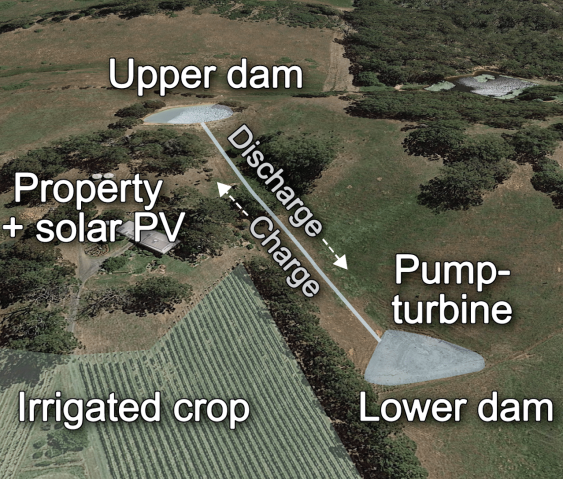Dam good energy storage
Laura Williams
18 September 2023, 3:40 AM
 Micro-pumped hydro energy storage systems store excess solar energy from high-production periods by pumping water to a high-lying reservoir, which is released back to a low-lying reservoir when more power is needed. Image: Supplied.
Micro-pumped hydro energy storage systems store excess solar energy from high-production periods by pumping water to a high-lying reservoir, which is released back to a low-lying reservoir when more power is needed. Image: Supplied.Renewable energy is fast becoming a major industry across the Western Plains, and the storage solutions could be in our backyards…if they’re big enough.
Research from UNSW suggests that farm dams have the potential to become small-scale hydro energy storage sites.
By connecting farm dams to form micro-pumped hydro energy storage systems, it could create tens of thousands of mini Snowy Hydro hydroelectric dams.
“The transition to low-carbon power systems like wind and solar photovoltaics needs cost-effective energy storage solutions at all scales,” said lead researcher Dr Nicholas Gilmore.
The systems would work to store solar energy when the sun is down, by pumping water to a high-lying reservoir, which is released back to a low-lying reservoir when more power is needed, flowing through a turbine-connected generator to create electricity.
While the idea is plausible by building reservoirs, it’s not cheap.
“We thought – if you’re geographically fortunate to have two significant water volumes separated with sufficient elevation, you might have the potential to have your own hydro energy storage system.”
The study used satellite imagery to pair reservoirs across Australia, filtering out those that might be commercially viable based on their capacity and slope.

Micro-pumped hydro energy storage systems store excess solar energy from high-production periods by pumping water to a high-lying reservoir, which is released back to a low-lying reservoir when more power is needed. Image: UNSW
Of nearly 1.7 million dams, over 30,000 sites were identified as potential hydro energy storage.
“We identified tens of thousands of these potential sites where micro-pumped hydro energy storage systems could be installed without undertaking costly reservoir construction,” Dr Gilmore said.
“That’s thousands of households that could potentially increase their solar usage, saving money on their energy bills, and reducing their carbon footprint.”
The average site could provide up to 2 kW of power and 30 kWh of usable energy – enough to back up a home for 40 hours.
The unique storage solution could also assist in power outages - which is common in rural areas - by providing a reliable backup power source.
“If there’s a power outage during a bushfire, for example, a pumped hydro system will give you enough energy to last a day, whereas a battery typically lasts around eight hours,” Dr Gilmore said.
While promising, the results come at a time of extended dry periods that are likely to continue, where water availability becomes unreliable, if at all.
“Our findings are encouraging for further development of this emerging technology, and there is plenty of scope for future technological improvements that will make these systems increasingly cheaper over time,” Dr Gilmore said.
Despite the research, there are no plans yet to move forward with a physical pilot site to test the viability of the project off paper.




